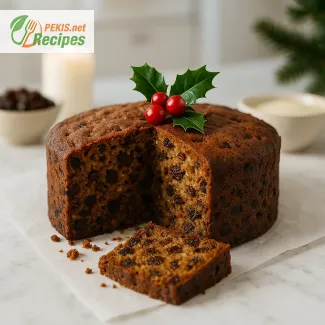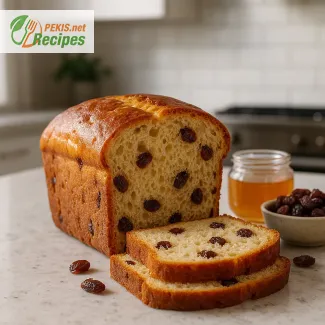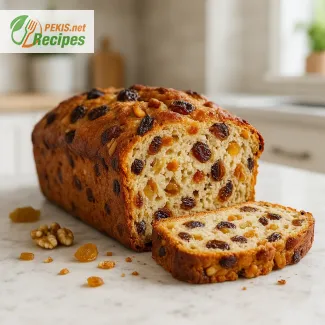Serves 4, with 40 minutes prep, 45 minutes cooking, and a total of 85 minutes, Beef Wellington combines beef fillet, puff pastry, and mushroom duxelles into a golden, crisp centerpiece. The tender meat is sealed with prosciutto and mustard, then baked until the pastry is flaky and rich in flavor. Ideal for festive occasions, it can be prepared ahead, stored at room temperature for 2 days, or frozen for up to 2 months. Reheated at 150 °C, it retains its texture and taste, making it both practical and impressive for celebrations.
PEKIS – professional chef and recipe developer with more than 25 years of experience, specializing in European and international cuisine. Over the years I’ve cooked countless versions of Beef Wellington, from traditional banquets to modern holiday tables, always focusing on getting the balance right between tender beef, rich mushroom duxelles, and buttery puff pastry. My hands-on work in both restaurants and private kitchens has given me a deep understanding of how to simplify this impressive dish without losing its elegance, making it achievable and rewarding for any cook.

Mastering the Art of Beef Wellington at Home
A festive centerpiece with layers of flavor and tradition
Golden, flaky puff pastry embracing tender beef fillet and earthy mushroom duxelles creates one of the most impressive dishes ever served at a holiday table. Known as Beef Wellington, this classic preparation captures the elegance of fine dining and transforms it into a celebratory meal that feels both indulgent and timeless. The crisp pastry crust shatters delicately under the knife, revealing perfectly cooked beef wrapped in an aromatic mushroom layer and often enhanced with prosciutto or a thin crêpe to seal in moisture.
The magic lies in the harmony of textures: the buttery crunch of pastry, the savory depth of mushrooms, and the juiciness of premium beef. For many cooks, this dish represents a pinnacle of culinary achievement, not only because of its taste but also because of its striking presentation. A beautifully baked Beef Wellington commands attention the moment it arrives at the table, radiating sophistication and warmth in equal measure.
Historical origins and cultural resonance
Though often associated with British cuisine, the origins of Beef Wellington have been debated by food historians. It is widely believed to have been named after the Duke of Wellington, celebrated for his victory at the Battle of Waterloo in 1815. Some suggest that the dish was adapted from the French filet de bœuf en croûte, popular at aristocratic banquets, then given an English identity to honor national pride. Over time, it evolved into a culinary icon, appearing on menus at festive gatherings, high-end restaurants, and now increasingly in home kitchens seeking a touch of grandeur.
Why you will love this dish
- Visual impact: The golden crust makes a dramatic entrance at the table.
- Luxurious flavor: Premium beef combined with earthy mushrooms creates a rich taste.
- Versatility: Can be customized with different fillings or accompaniments.
- Celebratory feel: Ideal for Christmas, New Year’s Eve, weddings, and anniversaries.
- Make-ahead potential: Prepares well in advance, reducing stress on event days.
Core elements that define Beef Wellington
At the heart of this dish are three essential components working in perfect balance:
- Beef fillet: Centerpiece of the recipe, offering tenderness and natural juices that must be carefully preserved.
- Mushroom duxelles: Finely chopped mushrooms cooked down with shallots, herbs, and sometimes a splash of wine, delivering an earthy counterpoint.
- Puff pastry: A delicate, buttery casing that protects the beef and adds irresistible crunch.
Optional additions such as prosciutto or crêpes serve a structural role, acting as barriers against excess moisture and ensuring the pastry remains crisp. Each layer contributes not only to flavor but also to the elegant presentation that makes Beef Wellington so memorable.
Storage and make-ahead preparation
- Room temperature: Up to 2 days when wrapped securely and kept in a cool place.
- Freezing: Can be frozen uncooked for up to 2 months, tightly sealed to prevent freezer burn.
- Reheating: Bake at 150 °C (300 °F) for 8–10 minutes to restore crispness without overcooking the beef.
This flexibility allows hosts to plan ahead, assembling the dish in stages and ensuring flawless results even for large gatherings.
Creative variations on the classic
- Individual Wellingtons: Smaller, single-portion versions baked for personalized servings.
- Vegetarian Wellington: Layers of roasted vegetables, spinach, and nuts wrapped in puff pastry.
- Seafood twist: Salmon Wellington with spinach and cream cheese filling.
- Flavored pastry: Herb-infused or seeded pastry dough for an added layer of character.
- Spiced duxelles: Incorporating truffle, chestnuts, or exotic mushrooms to deepen the earthy notes.
Serving ideas and complementary pairings
Beef Wellington shines when paired with classic sides such as roasted potatoes, glazed carrots, or a rich red wine reduction sauce. Seasonal vegetables bring balance to the richness, while a robust wine, such as Cabernet Sauvignon or Bordeaux, enhances the flavors of beef and pastry. For festive occasions, even sparkling wine provides a celebratory contrast to the buttery layers.
Semantically rich insights: Beef Wellington as a culinary statement
Beef Wellington is more than just a main course; it is a culinary performance that blends gastronomy, heritage, and presentation. The layers of pastry, beef, and duxelles symbolize precision and patience in the kitchen. Serving it signals not only an appreciation for tradition but also a readiness to elevate dining experiences to something unforgettable. By understanding its composition and heritage, every cook can create a dish that resonates with both history and personal creativity.
- Season the beef fillet generously with salt and black pepper. Heat olive oil in a pan and sear the beef on all sides until browned. Remove and let it cool slightly. Brush with Dijon mustard.
- In the same pan, melt butter and add shallots, garlic, mushrooms, and thyme. Cook until the mixture releases its moisture and becomes a dry paste (duxelles). Cool completely.
- Lay a sheet of plastic wrap on a work surface. Arrange prosciutto slices slightly overlapping, forming a rectangle large enough to wrap the beef. Spread the mushroom duxelles evenly on top.
- Place the seared beef fillet in the center and carefully roll it with the prosciutto and duxelles using the plastic wrap. Twist ends tightly to form a log. Chill in the refrigerator for 20 minutes.
- Roll out the puff pastry into a rectangle. Remove the beef roll from plastic wrap and place it in the center of the pastry. Wrap tightly, sealing edges. Trim excess pastry and tuck ends underneath.
- Brush the pastry with beaten egg for a golden finish. Optionally score the surface with a sharp knife for decoration.
- Chill the wrapped beef for 10 minutes, then bake in a preheated oven at 200 °C (400 °F) for 40–45 minutes until pastry is golden brown and beef reaches desired doneness.
- Rest for 10 minutes before slicing and serving.
FAQ questionWhat cut of beef is best for Beef Wellington?
Use a center-cut beef tenderloin (fillet) with uniform thickness so it cooks evenly. Aim for a neat cylinder shape (trim and tie if needed) about 700–900 g for four servings. Choose meat with fine marbling for tenderness, and pat it very dry before searing to help the crust form.
FAQ questionHow do I keep the pastry from getting soggy?
Cook the mushroom duxelles until completely dry—it should be a paste, not wet. Chill it before wrapping. Add a moisture barrier such as prosciutto or a thin crêpe around the beef and duxelles. Chill the wrapped log 20–30 minutes to firm it up, then bake on a preheated tray. Lightly score the pastry to vent steam and use a thin egg wash to avoid excess moisture.
FAQ questionWhat internal temperature should I aim for?
For medium-rare, remove the Wellington when the center reaches 50–52 °C (122–126 °F); carryover heat will bring it to 54–57 °C (130–135 °F) while resting. For medium, pull at 55–57 °C (131–135 °F) to finish around 60–63 °C (140–145 °F). Insert a thermometer from the side into the beef’s center and rest 10–15 minutes before slicing.
FAQ questionCan I make Beef Wellington ahead or freeze it?
Yes. Sear the beef and cook the duxelles up to 48 hours ahead (refrigerated). Assemble the Wellington and refrigerate up to 24 hours before baking. For longer storage, freeze uncooked (well wrapped) for up to 2 months. Thaw overnight in the fridge, then egg-wash and bake at 200 °C (400 °F); if still slightly icy, allow 10–15 minutes extra and monitor the internal temperature.
FAQ questionDo I really need prosciutto or a crêpe? What are alternatives?
They’re not mandatory, but a prosciutto or crêpe layer is the most reliable moisture barrier for a crisp pastry. If avoiding pork, use turkey ham, a thin plain crêpe, or even one sheet of phyllo brushed lightly with butter. Avoid wet greens; if using spinach, sauté and squeeze dry thoroughly first.
FAQ questionCan I make individual Beef Wellingtons?
Absolutely. Portion the tenderloin into 180–200 g pieces and wrap each with duxelles and pastry. Bake at 200 °C (400 °F) for about 22–28 minutes, checking internal temperature rather than time. Individual portions deliver faster, more predictable doneness and elegant plating.
FAQ questionWhat’s the best way to reheat leftovers without overcooking?
Reheat slices on a wire rack over a tray at 150 °C (300 °F) for 8–10 minutes to revive a crisp pastry while keeping the beef pink. Avoid microwaving (it softens pastry). If reheating a larger piece, cover the cut face with foil to prevent drying and check the center temperature frequently.
A perfectly prepared Beef Wellington is more than just a meal—it is a statement of skill, patience, and celebration. From the delicate puff pastry that turns golden in the oven to the rich layer of mushroom duxelles and the tender beef fillet at its core, every element works together to create harmony on the plate. The result is a dish that feels luxurious yet comforting, making it a centerpiece worthy of any festive occasion.
The versatility of this classic allows for countless variations. Whether crafted as a traditional whole fillet wrapped in prosciutto or reimagined into individual Wellingtons for elegant plating, it adapts to both intimate dinners and large gatherings. Creative adjustments such as vegetarian fillings, seafood alternatives, or herb-infused pastry bring fresh character without losing the sophistication that defines the original.
Practicality is part of its appeal. With the ability to prepare in advance, refrigerate, freeze, and reheat while retaining flavor and texture, Beef Wellington proves as functional as it is spectacular. This balance of indulgence and convenience makes it an ideal choice for modern kitchens where time and impact both matter.
Ultimately, the enduring charm of Beef Wellington lies in its dual nature: a reflection of culinary tradition and a canvas for personal creativity. By mastering its essential layers and experimenting with thoughtful variations, any cook can transform this historic dish into a memorable experience that delights every guest at the table.
Allergens present in the recipe:
- Gluten (from puff pastry)
- Dairy (butter)
- Eggs (egg wash)
Substitution tips for allergens:
- Use gluten-free puff pastry to eliminate gluten.
- Replace butter with plant-based margarine for a dairy-free version.
- Use a plant-based milk wash instead of egg for brushing.
- Vitamin B12: 3 µg – supports red blood cell formation and neurological function
- Vitamin D: 1.2 µg – important for bone health and immunity
- Vitamin A: 150 µg – contributes to vision and skin health
- Iron: 5.8 mg – essential for oxygen transport in blood
- Zinc: 6.2 mg – supports immune defense and wound healing
- Potassium: 720 mg – regulates fluid balance and muscle function
- Magnesium: 42 mg – contributes to energy metabolism and nerve function
- Selenium: 38 µg – protects cells from oxidative stress
- Vitamin E: 2.1 mg – contributes to skin protection and immune defense
- Polyphenols (from mushrooms and olive oil): 120 mg – reduce inflammation and support heart health





